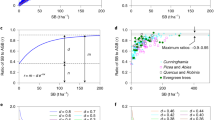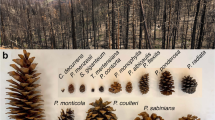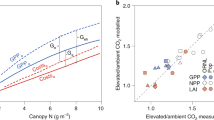Abstract
THE self-thinning rule is perhaps the most widely applicable principle in plant population dynamics. White1 has shown that it applies to more than 70 species ranging from herbs to trees, in many nutrient conditions. The rule states that W=Kp−3/2, where W is average plant weight, p is the density of plants, and K is a constant. In other words when the log of average weight is plotted against the log of average density for a crowded even-aged plant population, numbers must be lost as the individuals gain weight in such a way that the population's trajectory is held under a line of slope −3/2.
This is a preview of subscription content, access via your institution
Access options
Subscribe to this journal
Receive 51 print issues and online access
$199.00 per year
only $3.90 per issue
Buy this article
- Purchase on Springer Link
- Instant access to full article PDF
Prices may be subject to local taxes which are calculated during checkout
Similar content being viewed by others
References
White, J., Nineteenth Int. bot. Cong., Leningrad (1975).
White, J., and Harper, J. L., J. Ecol., 58, 467–485 (1970).
Kays, S., and Harper, J. L., J. Ecol., 62, 97–106 (1974).
Hiroi, T., and Monsi, M. J. Faculty Sci. Tokyo Univ., III 9, 241–285 (1966).
Blackman, G. E., and Wilson, G. L., Ann. Bot. N.S., 15, 63–94 (1951).
Black, J. N. J. appl. Ecol. 1, 3–18 (1963).
Author information
Authors and Affiliations
Rights and permissions
About this article
Cite this article
WESTOBY, M. Self-thinning driven by leaf area not by weight. Nature 265, 330–331 (1977). https://doi.org/10.1038/265330a0
Received:
Accepted:
Issue Date:
DOI: https://doi.org/10.1038/265330a0
This article is cited by
-
Structural complexity governs seagrass acclimatization to depth with relevant consequences for meadow production, macrophyte diversity and habitat carbon storage capacity
Scientific Reports (2019)
-
Self-thinning lines and allometric relation in Chinese fir (Cunninghamia lanceolata) stands
Journal of Forestry Research (2015)
-
Generalisation of self-thinning of plant populations
Nature (1977)
-
Plant self-thinning dynamics
Planta (1977)
Comments
By submitting a comment you agree to abide by our Terms and Community Guidelines. If you find something abusive or that does not comply with our terms or guidelines please flag it as inappropriate.



